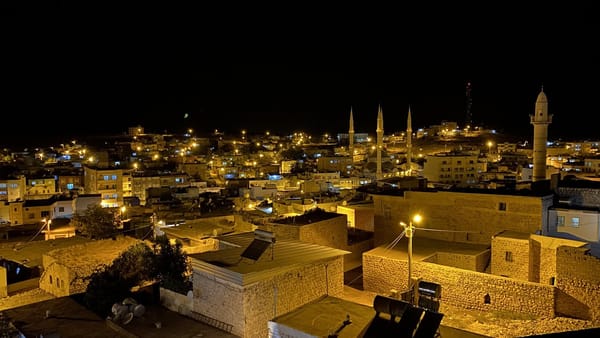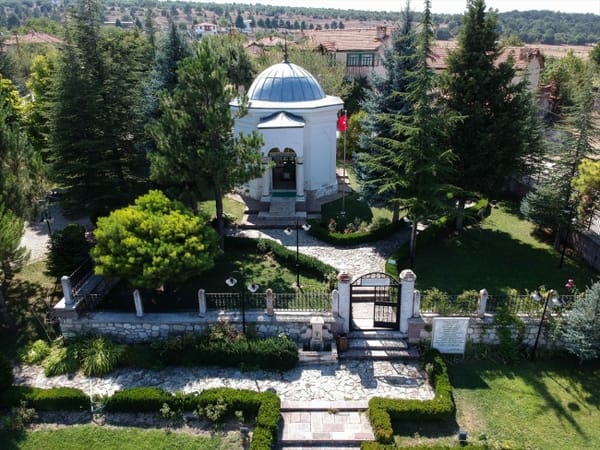The Ultimate Guide to the Carian Trail: Turkey's Hidden Gem Trek

Turkey is a land steeped in history, a crossroads of civilizations, and a treasure trove for adventurers. While the Lycian Way has rightfully earned its fame, a lesser-known, yet equally spectacular, long-distance trail beckons those seeking authentic experiences and untouched landscapes: the Carian Trail. Spanning the ancient heartland of Caria in southwestern Turkey, this 800-kilometer network of paths offers a profound journey through time, culture, and breathtaking natural beauty.
This guide is your definitive roadmap to conquering the Carian Trail. We'll dissect its routes, delve into its rich history, arm you with essential planning knowledge, and reveal why this "hidden gem" should be your next trekking obsession.
What is the Carian Trail? An Introduction to Turkey's Ancient Footpath
The Carian Trail, or "Karia Yolu" in Turkish, is more than just a hiking path; it's a meticulously curated network of ancient footpaths, shepherd trails, and old trade routes that wind through the historical region of Caria. This vast system, primarily located in the provinces of Muğla and Aydın, connects remote villages, pristine coves, and remarkable archaeological sites, offering an immersive experience into the soul of southwestern Turkey.
Defining the Carian Trail
- Origin and History: Developed and waymarked by keen hikers and locals, the trail draws inspiration from the ancient Carian civilization, a seafaring people who dominated this region from the 2nd millennium BC. The routes often follow paths used for centuries by locals and ancient travelers.
- Location: Southwestern Turkey, tracing the Aegean coastline and extending inland through mountainous terrain. It primarily covers the Muğla and Aydın provinces, encompassing areas like the Datça and Bozburun Peninsulas, the Gulf of Gökova, and the Carian Hinterland.
- Total Length: The trail is approximately 800 kilometers long, though various extensions and alternative routes exist. It’s typically divided into five main sections, with numerous smaller stages within each.
- The "Hidden Gem" Appeal: Unlike more developed trails, the Carian Trail offers an unparalleled sense of discovery. It leads you through landscapes largely untouched by mass tourism, allowing for genuine interaction with local culture and a deep connection with nature and history.
Why Hike the Carian Trail? Beyond the Crowds
While the Lycian Way offers stunning coastal vistas, the Carian Trail provides a more diverse and historically layered experience.
- Authenticity: This is where you escape the tourist throngs. You'll encounter genuine village life, taste traditional home-cooked meals, and experience the warm hospitality that defines rural Turkey.
- Historical Immersion: The trail is a living museum. You'll walk amongst the ruins of ancient Carian cities, discover forgotten tombs, and trace the footsteps of civilizations that shaped the Mediterranean world.
- Diverse Landscapes: From the turquoise waters of the Aegean to rugged mountain peaks, fragrant olive groves, and serene lakeside paths, the Carian Trail offers a constantly changing panorama that will captivate your senses.
- A Deeper Connection: By immersing yourself in the less-traveled paths, you forge a more profound connection with the land and its history, creating memories that resonate long after you've returned home.
A Journey Through History: The Legacy of Ancient Caria
The Carian Trail is intrinsically linked to its past. Understanding the Carian people adds a profound dimension to the trekking experience.
The Carian Civilization
The Carians were an ancient Anatolian people who inhabited Caria, a region in southwestern Anatolia. Known for their maritime prowess and often serving as mercenaries for larger empires, they were a significant force in the region for centuries. Their legacy is etched into the landscape through the numerous archaeological sites scattered along the trail.
Echoes of the Past: Ancient Sites Along the Trail
As you traverse the Carian Trail, you'll encounter a wealth of historical treasures.
- Knidos: A magnificent ancient port city at the tip of the Datça Peninsula, famed for its astronomical observatory, theatre, and impressive Hellenistic and Roman ruins.
- Pedasa: An ancient Carian city near modern-day Bodrum, offering a glimpse into early fortifications and urban planning.
- Labranda: A sacred sanctuary dedicated to Zeus Labraundos, located inland, featuring temples, altars, and a unique Doric stoa.
- Stratonikeia: An ancient city with well-preserved structures, including a theatre, stadium, and agoras, showcasing Hellenistic, Roman, and Byzantine periods.
Beyond these major sites, the trail is dotted with countless smaller ruins, ancient tombs, Byzantine churches, and Ottoman-era structures, each telling a story of the civilizations that have called this land home. Expect to stumble upon numerous smaller ruins and tombs as you hike.
Navigating the Carian Trail: Sections, Maps, and Stages
The Carian Trail is not a single path but a network. Understanding its structure is key to planning your adventure.
Understanding the Trail Structure
The trail is typically divided into five main sections, each offering unique characteristics and challenges:
- Bozburun Peninsula (approx. 148 km): Known for its tranquil bays, hilltop fortresses, and traditional villages, this section offers a quintessential Aegean coastal experience.
- Datça Peninsula (approx. 155 km): More remote and wild, this peninsula boasts stunning, undeveloped beaches and offers a sense of true isolation, ideal for experienced hikers and campers.
- Gulf of Gökova (approx. 243 km): The longest section, this route features dramatic coastal climbs, descends to the sea, passes through the "slow city" of Akyaka, and offers glimpses into the less-explored hinterlands around Bodrum.
- Carian Hinterland/Latmos (approx. 185 km): Moving inland, this section delves into mountainous terrain, traditional culture, and the unique landscape surrounding Lake Bafa, with its ancient rock art.
- Muğla Environs (approx. 119 km): This section connects key areas, passing through the ancient city of Thera, the Değirmendere Canyon, and ending near Stratonicea, offering a mix of dirt tracks and forest paths.
The entire trail can take anywhere from 30 to 46 days to complete, but it’s easily segmentable for shorter treks.
Essential Carian Trail Map & GPS Data
Navigation is paramount. The official cariantrail.com website is the primary resource for up-to-date maps and GPS tracks. Utilizing apps like Wikiloc or Komoot, which often host Carian Trail GPX files, is highly recommended. Always carry a physical map and compass as a backup.
Choosing Your Adventure: Best Sections for Shorter Treks
Don’t have a month? No problem. The Carian Trail is highly adaptable:
- For Coastal Charm & History (7-10 Days): Focus on the Datça Peninsula (e.g., Datça to Palamutbükü) or the Bozburun Peninsula (e.g., Marmaris region trails). These offer a good balance of scenery, ruins, and manageable logistics.
- For a Mix of Coast & Inland Culture (10-14 Days): Combine sections of the Gulf of Gökova with the start of the Carian Hinterland. This provides variety in landscape and experience.
- For the Dedicated History Buff (10-14 Days): Focus on the Muğla Environs and the Carian Hinterland, linking ancient sites like Stratonikeia with the unique beauty of Lake Bafa.
Planning Your Carian Trail Adventure: The Practicalities
Success hinges on meticulous planning. Here’s what you need to know:
When to Hike the Carian Trail: The Best Seasons
The Mediterranean climate dictates the ideal hiking periods.
- Ideal Months: Spring (April-May) and Autumn (September-October).
- Spring: Wildflowers are in bloom, temperatures are mild (averaging 15-25°C), and water sources are generally plentiful.
- Autumn: Temperatures remain pleasant (averaging 20-30°C), the sea is still warm enough for swimming, and the landscapes take on golden hues.
- Summer (June-August): Avoid this period. Temperatures frequently exceed 35-40°C, making hiking extremely dangerous and unpleasant. Water sources can also become scarce.
- Winter (November-March): While possible for hardy, experienced hikers, days are shorter, temperatures are cooler, and rainfall can be significant. Some services in smaller villages may be closed.
Carian Trail Difficulty & Fitness Requirements
The Carian Trail presents a moderate to challenging hiking experience.
- Terrain Variety: Expect a mix of coastal paths, rocky and uneven terrain, forest tracks, agricultural paths, and some sections of old cobblestone or paved roads.
- Elevation Changes: Many sections involve significant ascents and descents, particularly when moving between coastal villages and higher vantage points or inland mountains. Daily elevation gains can range from a few hundred meters to over 1000 meters.
- Fitness Level: A good level of general fitness is required. Prior experience with multi-day hiking, including navigating varied terrain and managing your own supplies, is highly recommended, especially for longer or more remote sections. Be prepared for days where you hike 15-25 km with substantial elevation changes.
What to Pack for the Carian Trail: Essential Gear List
Overpacking is a common mistake. Pack smart, not heavy.
- Footwear: Broken-in, sturdy hiking boots with good ankle support and grip are essential. Consider lightweight trail runners if you prefer less weight and are confident on rocky terrain.
- Clothing:
- Moisture-wicking base layers (merino wool or synthetic).
- Hiking trousers or shorts.
- Fleece jacket or mid-layer for cooler mornings/evenings.
- Waterproof and windproof outer shell.
- Sun-protective clothing (long sleeves, hat).
- Backpack: A comfortable 40-60 liter backpack for multi-day treks. A daypack (15-25 liters) is sufficient if you are using support services or staying in accommodations each night.
- Navigation:
- Reliable GPS device or smartphone with offline maps (e.g., Maps.me, Komoot, Gaia GPS).
- Downloaded GPX tracks for the Carian Trail.
- Physical map and compass (and knowledge of how to use them).
- Water Management:
- Water bottles or hydration reservoir (minimum 2-3 liters capacity).
- Water filter or purification tablets – crucial for refilling from natural sources.
- Sun Protection: Wide-brimmed hat, sunglasses, high SPF sunscreen.
- First-Aid Kit: Comprehensive kit including blister treatment, pain relievers, antiseptic wipes, bandages, and any personal medications.
- Other Essentials:
- Trekking poles (highly recommended for ascents/descents).
- Headlamp with spare batteries.
- Lightweight sleeping bag liner (if camping or staying in basic pensions).
- Power bank for electronics.
- Quick-dry towel.
- Basic toiletries.
- Snacks for the trail.
Carian Trail Accommodation Options
The trail offers a range of accommodation, blending comfort with rustic charm.
- Guesthouses (Pansiyons): Found in most villages and small towns along the route, offering basic but comfortable rooms, often with breakfast included. This is the most common and recommended option for immersing in local life.
- Small Hotels: Available in larger towns like Bodrum, Datça, and Akyaka, offering more amenities.
- Camping: Wild camping is generally tolerated in more remote areas, but always practice Leave No Trace principles. Some designated campsites or basic facilities might be available near popular spots. Booking ahead is advisable, especially during peak season.
Getting There and Around
- Nearest Airports:
- Milas-Bodrum Airport (BJV): Serves the northern parts of the trail, including Bodrum and Datça (via ferry or bus).
- Dalaman Airport (DLM): Serves the southern parts, including Marmaris, Akyaka, and Fethiye.
- Transportation to Trailheads:
- Dolmuş (Minibuses): The most common and affordable way to travel between towns and villages.
- Taxis: Readily available but more expensive.
- Rental Cars: Offer flexibility but can be challenging on some rural roads and parking at trailheads might be limited.
- Luggage Transfer Services: Increasingly available for hikers who prefer to walk with just a daypack.
Trail Markings and Navigation
The Carian Trail is marked with red and white blazes, similar to the Lycian Way. However, markings can vary in consistency. Always supplement visual cues with GPS data. The official cariantrail.com website and associated GPX files are your best allies.
Carian Trail vs. Lycian Way: Which Trail is Right for You?
Both are exceptional Turkish hiking experiences, but they cater to slightly different preferences.
Direct Comparison
- Carian Trail:
- Focus: Deeper historical immersion, broader range of landscapes (including more inland/mountainous sections), emphasis on authentic village life, less developed infrastructure.
- Vibe: Discoverer's trail, raw authenticity, historical depth.
- Lycian Way:
- Focus: Primarily coastal, more established infrastructure, potentially more crowded sections, strong emphasis on turquoise sea views.
- Vibe: Classic Mediterranean hike, well-trodden paths, stunning coastal panoramas.
Making Your Choice
- Choose the Carian Trail if: You're a history enthusiast, crave genuine cultural interaction, seek quieter trails, and appreciate diverse landscapes beyond just the coast.
- Choose the Lycian Way if: Your priority is constant sea views, you prefer more developed infrastructure and a more established trail system, or you're a beginner looking for a slightly more predictable experience.
Many hikers choose to combine sections of both for a comprehensive exploration of Turkey's ancient hiking routes.
Essential Tips for a Safe and Rewarding Carian Trail Experience
Preparation and awareness are key to a successful trek.
Safety First: Staying Safe on the Trail
- Water Sources: This is critical. While villages offer water, sections between them can be long and arid. Always carry more water than you think you’ll need and know where your next refill point is. A water filter is a wise investment.
- Heat and Sun Exposure: During spring and autumn, the sun can still be intense. Start hikes early in the morning to avoid the midday heat, wear protective clothing, and take breaks in shaded areas.
- Wildlife: Be aware of snakes, scorpions, and other wildlife. Stick to marked paths, wear sturdy footwear, and never disturb animals.
- Communication: Mobile signal can be patchy in remote areas. Inform someone of your daily route and expected arrival time. Carry a fully charged phone and a power bank.
- Wildfire Impact: CRITICAL ADVISORY: Wildfires in August 2021 significantly impacted sections of the Bozburun Peninsula and the Gökova region. Some routes remain closed or are subject to change due to recovery efforts (logging, trail repair). Always check the official website or their Wikiloc page for the most current route status and potential closures before and during your trek. Be prepared for detours.
Connecting with Locals and Culture
- Hospitality: Turkish people are renowned for their warmth. A smile and a few basic Turkish phrases (Merhaba - Hello, Teşekkürler - Thank you) go a long way in fostering positive interactions.
- Respect: Dress modestly when passing through villages, especially when visiting religious sites. Always ask permission before taking photos of people.
Food and Supplies
- Resupply: Smaller villages often have small grocery stores (bakkal) where you can buy essentials like water, snacks, and basic food items. Larger towns offer more variety. Plan your resupply points carefully, especially for longer stretches.
- Local Cuisine: Embrace the local food! Try gözleme (savory Turkish pancake), fresh cheeses, olives, seasonal fruits, and regional specialties.
Best Practices for Responsible Hiking
- Leave No Trace: Pack out everything you pack in. Stay on marked trails to prevent erosion. Respect the natural environment and cultural heritage.
- Support Local: Stay in local pansiyons, eat at village restaurants, and buy local crafts. This directly benefits the communities that maintain the trail.
Frequently Asked Questions (FAQs) about the Carian Trail
Q1: How long is the Carian Trail?
The Carian Trail is approximately 800 kilometers long, comprising five main sections and numerous stages.
Q2: What is the best time of year to hike the Carian Trail?
The ideal times are spring (April-May) and autumn (September-October) for pleasant temperatures and good hiking conditions. Summer is too hot.
Q3: What is the difficulty level of the Carian Trail?
The trail is generally considered moderate to challenging, with varied terrain, significant elevation changes, and remote sections requiring good fitness and navigation skills.
Q4: Is the Carian Trail well-marked?
It is marked with red and white blazes, but consistency can vary. Using GPS tracks and a map is essential for reliable navigation.
Q5: What are the main sections of the Carian Trail?
The five main sections are the Bozburun Peninsula, Datça Peninsula, Gulf of Gökova, Carian Hinterland/Latmos, and Muğla Environs.
Q6: What should I pack for the Carian Trail?
Essential items include broken-in hiking boots, layers of moisture-wicking clothing, a good backpack, navigation tools (GPS/maps), water purification, sun protection, and a comprehensive first-aid kit.
Q7: How do I get to the Carian Trail starting points?
The closest airports are Milas-Bodrum (BJV) and Dalaman (DLM). From there, local transport like dolmuş (minibuses) or taxis can take you to various trailheads.
Resources for Your Carian Trail Trek
Empower your journey with the right tools and information.
Official Trail Information
- The Carian Trail Official Website: cariantrail.com - Your primary source for route details, maps, and updates.
Recommended Guidebooks & Maps
- The Carian Trail Guidebook: Look for detailed guidebooks specifically covering the trail, often available in print or digital formats. These provide in-depth route descriptions and historical context.
Useful Apps & Websites
- Wikiloc: A popular platform for sharing GPS tracks, often featuring Carian Trail routes contributed by users.
- Komoot, AllTrails, Maps.me: Excellent apps for offline navigation and trail discovery.
The Carian Trail is an odyssey for the soul, a journey that rewards the intrepid with unparalleled beauty, deep historical resonance, and authentic cultural encounters. It’s a chance to step off the beaten path and into a narrative woven by ancient civilizations and enduring traditions.
Don't just dream about it; plan it. Equip yourself with the knowledge from this guide, embrace the challenge, and prepare for an unforgettable adventure through the heart of ancient Caria.
Image Sources: cariantrail.com, petersommer.com


